Medicine Buddha Teachings
Khenchen Thrangu Rinpoche
Snow Lion 2004
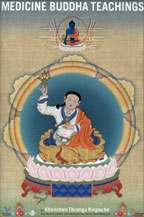 Medicine Buddha Teachings is the edited transcript of teachings given
by Venerable Khenchen Thrangu Rinpoche at an eight-day retreat in Washington’s
Cascade region. What makes this book so readable, enjoyable, devotional and practical
is the sense that you are there as part of the retreat. At the very beginning
of the book, readers are welcomed and given instructions on how to approach
the teachings: “Please generate strong devotion for the root guru and other
gurus of the lineage…please think that you are listening to them…”
Medicine Buddha Teachings is the edited transcript of teachings given
by Venerable Khenchen Thrangu Rinpoche at an eight-day retreat in Washington’s
Cascade region. What makes this book so readable, enjoyable, devotional and practical
is the sense that you are there as part of the retreat. At the very beginning
of the book, readers are welcomed and given instructions on how to approach
the teachings: “Please generate strong devotion for the root guru and other
gurus of the lineage…please think that you are listening to them…”
Khenchen Thrangu Rinpoche constantly reminds us that the motivation for receiving
the teachings is extremely important. We need to be physically and mentally healthy
in order to establish “a stable and profound practice” to be of benefit
to all beings.
The book contains the Medicine Buddha Sadhana in Tibetan with an English translation,
and commentaries on the Medicine Buddha Sutras. There are many practices given
in this book, from the simple repetition of the name of Medicine Buddha to very
complex visualizations. Khenchen Thrangu Rinpoche’s wisdom and patience
shine through as he guides us through the practices and the basic principles of
Tantric theory. Because of the direct relation between mind and body, we can experience
decreased illness and suffering by meditating on the Medicine Buddha:
“Visualize the Medicine Buddha four fingers high in an afflicted place in
your body and think that from this small but vivid form rays of light are emitted.
These rays are not simply light, which is dry, but liquid light having the quality
of ambrosia. This luminous ambrosia actually cleanses and removes the sickness
and pain.”
There are many valuable teachings in this book. So make yourself receptive as
the Buddha instructed – listen well, listen fully and hold this in your
mind.
At the end of the retreat, Khenchen Thrangu Rinpoche thanked people for taking
time out of their busy lives to come and hear the teachings, and said that by
coming they had somehow awakened their Buddha nature and can begin to attain liberation.
– Swami Radhananda
back to top
Healing Yoga for People Living with Cancer
Lisa Holtby
Taylor Trade 2004
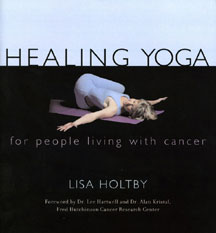 People with serious illnesses are turning to yoga in increasing numbers because
it is both an intelligent system for physical revitalization, and a calming centring
practice that helps reduce the emotional toll of illness.
People with serious illnesses are turning to yoga in increasing numbers because
it is both an intelligent system for physical revitalization, and a calming centring
practice that helps reduce the emotional toll of illness.
Lisa Holtby provides a beautiful and compassionately written guide for people
living with cancer who want to help themselves. Her instructions are clear and
complete yet simple enough for beginners. Most importantly, she infuses every
page with positive affirmations that are genuine and uplifting without being saccharine.
The core of the book is six sections that build from the most basic warm-ups to
more vigorous postures. It is clear from her introductory segments and the guidelines
for each exercise that she knows her audience; she has worked with cancer patients
and designed this program based on what worked best for them.
The first two practice segments address attitude and breathing, both foundational
for a holistic practice of yoga. Ms. Holtby writes in down-to-earth language about
subtle aspects of experience, such as how to set an intention, the sensations
of breathing, and how to get behind the clutter of the mind’s chatter. Her
writing style is natural and welcoming, with a personal touch that inspires confidence
and invites a deep personal exploration on the part of the student.
The four sections of asana (ten poses in each, with English and Sanskrit
names) progress from gentle chair poses to gentle floor poses, to more vigorous
strength-building floor poses, to standing poses. There are at least two variations
of each pose, one more gentle and one more intense. The book concludes with
an anatomy primer and a comprehensive resource guide. This is a must-have book
for all those who want to help themselves through difficult times with yoga
– Ellen Saltonstall
back to top
Father Joe: The Man Who Saved My Soul
Tony Hendra
Random House 2004
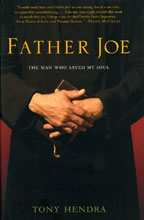 Tony Hendra is best known as a writer and satirist who co-wrote This Is Spinal
Tap, a seminal comedy about a fictional 1970s rock band that inspired an
entire film genre – the mockumentary. Hendra’s writing with National
Lampoon in the late ’60s and early ’70s helped a generation of
North Americans express their growing cynicism and frustration with politics and
religion. What is less known about Hendra is his spiritual side.
Tony Hendra is best known as a writer and satirist who co-wrote This Is Spinal
Tap, a seminal comedy about a fictional 1970s rock band that inspired an
entire film genre – the mockumentary. Hendra’s writing with National
Lampoon in the late ’60s and early ’70s helped a generation of
North Americans express their growing cynicism and frustration with politics and
religion. What is less known about Hendra is his spiritual side.
Father Joe begins with a fourteen-year-old Tony getting caught in
an affair with a married Catholic woman. He is sent off to meet Father Joseph
Warrillow, an unconventional Benedictine monk chosen to mete out punishment
for the boy’s sin. Much to Hendra’s surprise he is not admonished,
and he eventually becomes so enthralled with the life of a monk that he tries
unsuccessfully to take the vows and gain acceptance into the abbey for many
years to come.
While there are some notable holes in Father Joe, particularly in
regard to Hendra’s two wives, I found that I could connect to Father
Joe on a number of levels. Like Hendra, and like many people I know who
grew up inside the Church, I also for a time considered taking vows and staying
inside the tradition in a more formal way.
I was also inspired by Hendra’s struggles with satire itself. Having convinced
himself that making people laugh was a noble pursuit, Hendra was unable to understand
why he took so little personal pleasure in it himself. In speaking to Father Joe,
Hendra realizes that the scabrous nature of satire – the skewering of a
subject at whatever cost – is born from a vindictive, vengeful place, and
not born from traditional Christian tenets, even if the result is laughter. As
someone who has often used humour as the last line of defense – and perhaps
too often as the first line of offense – I was interested in how a professional
satirist and spiritual devotee engages with the contradictions found in these
two pursuits.
Overall, I don’t know if Father Joe would be to everyone’s
taste, but I found myself greatly impressed by the deftness with which Hendra
dealt with spiritual and cultural matters. I was 32,000 feet above the Canadian
Rockies when I finished Father Joe, and was surprised to find myself
weeping – surprised to the point where I actually looked at the man next
to me to see if he could explain why the book in my lap was wet. He just looked
back at me with a puzzled expression. When I landed in Vancouver, I stopped
at an airport washroom to freshen up, only to find my face streaked with black
ink. I realized that my pen had exploded mid-flight, staining my hands, and
when I was weeping into my hands the ink transferred to my face. I found it
a fitting and comical end to a book that engaged and challenged me in considering
the role of satire and faith in my spiritual life. What else can you do, except
laugh?
– Scott W. Gray
back to top
Not Turning Away:The Practice of Engaged Buddhism
Susan Moon, ed.
Shambhala 2004
 Not Turning Away is a collection of writing from Turning Wheel: The
Journal of the Buddhist Peace Fellowship that brings forth the stories of
everyday people finding strength in the practice of engaged Buddhism. The book
captures twenty-five years of reflection on right action and Buddhist ideals in
practice. From San Quentin’s death row in California to Ambleside Beach
in West Vancouver, writers offer very personal insights on practising Buddhism
in, as editor Susan Moon writes, “lives being lived in the cross current
of our world.”
Not Turning Away is a collection of writing from Turning Wheel: The
Journal of the Buddhist Peace Fellowship that brings forth the stories of
everyday people finding strength in the practice of engaged Buddhism. The book
captures twenty-five years of reflection on right action and Buddhist ideals in
practice. From San Quentin’s death row in California to Ambleside Beach
in West Vancouver, writers offer very personal insights on practising Buddhism
in, as editor Susan Moon writes, “lives being lived in the cross current
of our world.”
Recounting personal stories, authors such as Thich Nhat Hanh and Marianne Dresser
convey the details of everyday life and avoid entrenching their words on social
action into the dichotomies of “right and wrong.” The essays bring
Buddhist principles into practice, asking, How can I live rightly? How can I bring
peace? And, as Joanna Macy says in her article “Buddhist Resources for Despair,”
in reference to social action in the nuclear age, “the inner work of social
change—it helps us expand our awareness of both the peril and the promise
of our time.”
Sally Clay’s “Healing and Empowerment” does a wonderful
job describing and normalizing social phenomena that are often stigmatized.
She deftly describes her experience living with a mental illness and how her
spiritual practice has helped her manage her own life and know her own mind.
And Lin Jenson, in his article “Bad Dog: From Shame to Compassion,”
illustrates how living his practice helps him move from agonizing memories of
an abusive relationship with his father to being able to care for his father
as an old and dying man.
Throughout the articles, writers return to themselves as a point of reference
in both the cause of illness and the effect of healing. In prescribing an anecdote
for peace, Thich Nhat Hanh urges that “when you have shown your capacity
for listening and understanding, the other person will begin to listen to you,
and you have a chance to tell him or her of your pain, and it’s your turn
to get healed. This is the practice of peace.”
The stories in Not Turning Away help me to understand my life experience
with more gentleness and appreciation for the people who have influenced it.
The book left me wanting more and was very effective in engaging me in further
exploration of Buddhism as a practice of peace. – Kendra Ward
back to top
Stabat Mater – Arvo Pärt
Christopher Jackson, Studio de musique ancienne de Montréal, Quatuor Franz Joseph & Daniel Taylor
ATMA Classique 2004
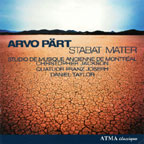 Arvo Pärt once said: “I have discovered that it is enough when a single
note is beautifully played.” On this outstanding new release, his words
ring long, clear and true. For thirty years, the Estonian composer has received
worldwide attention for his haunting, “tintinnabular” style, drawing
slow and beautiful music from medieval, Renaissance and Gregorian traditions.
Here, Quatuor Franz Joseph’s strings join the Studio de musique ancienne
de Montréal and Daniel Taylor to perform a handful of Pärt’s
finest works.
Arvo Pärt once said: “I have discovered that it is enough when a single
note is beautifully played.” On this outstanding new release, his words
ring long, clear and true. For thirty years, the Estonian composer has received
worldwide attention for his haunting, “tintinnabular” style, drawing
slow and beautiful music from medieval, Renaissance and Gregorian traditions.
Here, Quatuor Franz Joseph’s strings join the Studio de musique ancienne
de Montréal and Daniel Taylor to perform a handful of Pärt’s
finest works.
The album opens with “Psalom,” where measured phrases of violin, viola
and cello drift and weave together. The music seems to move not from note to note
but from silence to silence, each break in sound a held breath. When “Summa”
begins, the choir’s voices are like a sudden jolt of humanity; it’s
as if we are stepping out of a dark wood, seeing a human face for the first time
in years. Conductor Christopher Jackson leads the studio choir, letting the Latin
words of the Christian Creed rise and fall like breath.
When Pärt wrote “Fratres” in 1977, he included no specification
for instrumentation. Consequently, it has been arranged for a multitude of instruments,
from piano to percussion to orchestra. Here it is performed by string quartet,
the violin’s open chord a restful base for the other instruments’
winsome pulse.
“Es sang vor langen Jahren” lets Taylor’s high, plum voice sail
over the occasional nod of cello. The result is a desolate landscape whose stillness
is occasionally disturbed. “Stabat Mater,” the record’s twenty-nine-minute
finale, takes these feelings and extends them even further. The violin and violas
de gamba present long stretches of unmistakable sadness, and voices join them
in reverent prayer.
Great beauty, this album suggests, can be found in the most barren places. The
performers have outdone themselves, becoming the invisible conduits for joy and
despair. Arvo Pärt’s music does not only express the depths of the
human soul and the grief it can experience. But like a band of sunlight into a
darkened cave, “Stabat Mater” is also an affirmation of faith, of
the shimmering heights toward which our spirit can rise. After night has fallen,
there will inevitably be a dawn. – Sean Michaels
back to top
Rounds
Four Tet 2003
www.fourtet.net
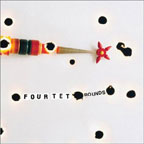 Four Tet’s latest album Rounds opens with a coarse organic beat,
the kind that is easily overlooked if you’ve got the volume too low.
Four Tet’s latest album Rounds opens with a coarse organic beat,
the kind that is easily overlooked if you’ve got the volume too low.
Picture this. You’re riding in the backseat of a car full of friends
well acquainted and silence is comfortable and easy. You’re in the city.
The sky is clear. You experience the slow motion of passenger life, free to
stretch your neck and look through the windows, taking it all in.
A simple drone rises up, and the foundation for all ten tracks on Rounds is laid
down.
Your altitude changes by way of underpass or overpass. Your sightline
increases and decreases in gentle rhythm. Telephone poles rise up to electrical
wires that dip along, crisscrossing tops of billboards and signposts. The lights
change. You stop. You go.
In the first track, Hands, the bright explosion of high hat and keyboard reveals
straight ahead drumbeats, rhythmic guitar and driving bass lines that are sharpened
with hypnotic electronic samples. As the album unfolds this relationship endures,
creating a soundscape that gets inside, takes hold and, strangely, puts a smile
on your face.
When I first bought Rounds I hadn’t yet heard of Four Tet and
wasn’t really familiar with anything electronic. Looking for something
new, something lyric-free and inspiring, I sat crowned with headphones before
a store’s CD player, cautiously pressed play, and was immediately drawn
in to the circular sounds of Rounds.
Four Tet is twenty-four-year-old Kieran Hebden, an electronic musician hailing
from London, UK. His music is characterized by striking acoustic elements artfully
layered with electronic samples. Inspired by the brilliant sounds of jazz artists
John Coltrane, Ornette Coleman and Albert Ayler, Hebden’s choices are intentional
and his music is relevant to the twenty-first century. His arrangements are sophisticated
and artful without being escapist or judgemental.
Listening to this album, I relax, breathe easy and am seduced by the subtle interplay
between electronic and acoustic sound. On the metro, in my apartment, stretched
out on the grass, I pull out Four Tet when I really want to plug in. – Tressa
Brotsky
back to top